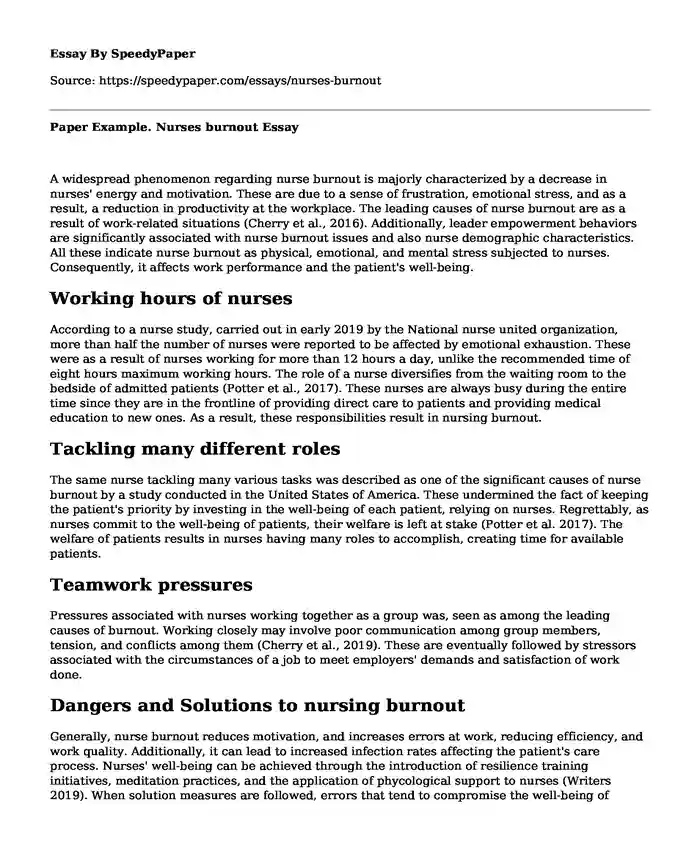
| Type of paper: | Course work |
| Categories: | Profession Stress Nursing care |
| Pages: | 2 |
| Wordcount: | 485 words |
A widespread phenomenon regarding nurse burnout is majorly characterized by a decrease in nurses' energy and motivation. These are due to a sense of frustration, emotional stress, and as a result, a reduction in productivity at the workplace. The leading causes of nurse burnout are as a result of work-related situations (Cherry et al., 2016). Additionally, leader empowerment behaviors are significantly associated with nurse burnout issues and also nurse demographic characteristics. All these indicate nurse burnout as physical, emotional, and mental stress subjected to nurses. Consequently, it affects work performance and the patient's well-being.
Working hours of nurses
According to a nurse study, carried out in early 2019 by the National nurse united organization, more than half the number of nurses were reported to be affected by emotional exhaustion. These were as a result of nurses working for more than 12 hours a day, unlike the recommended time of eight hours maximum working hours. The role of a nurse diversifies from the waiting room to the bedside of admitted patients (Potter et al., 2017). These nurses are always busy during the entire time since they are in the frontline of providing direct care to patients and providing medical education to new ones. As a result, these responsibilities result in nursing burnout.
Tackling many different roles
The same nurse tackling many various tasks was described as one of the significant causes of nurse burnout by a study conducted in the United States of America. These undermined the fact of keeping the patient's priority by investing in the well-being of each patient, relying on nurses. Regrettably, as nurses commit to the well-being of patients, their welfare is left at stake (Potter et al. 2017). The welfare of patients results in nurses having many roles to accomplish, creating time for available patients.
Teamwork pressures
Pressures associated with nurses working together as a group was, seen as among the leading causes of burnout. Working closely may involve poor communication among group members, tension, and conflicts among them (Cherry et al., 2019). These are eventually followed by stressors associated with the circumstances of a job to meet employers' demands and satisfaction of work done.
Dangers and Solutions to nursing burnout
Generally, nurse burnout reduces motivation, and increases errors at work, reducing efficiency, and work quality. Additionally, it can lead to increased infection rates affecting the patient's care process. Nurses' well-being can be achieved through the introduction of resilience training initiatives, meditation practices, and the application of phycological support to nurses (Writers 2019). When solution measures are followed, errors that tend to compromise the well-being of patients and nurses will not be experienced.
References.
Cherry, B., & Jacob, S. R. (2016). Contemporary nursing: Issues, trends, & management. Elsevier Health Sciences.
Potter, P.A., Perry, A.G., Stockert, P., & Hall, A. (2017). Fundamentals of nursing. (9th ed.) St. Louis, MO: Elsevier.
Writers, S. (2019). Avoiding burnout as a Nurse | Nursing.org. Retrieved 22 February 2020, from https://www.nursing.org/resources/nurse-burnout/
Cite this page
Paper Example. Nurses burnout. (2023, Apr 05). Retrieved from https://speedypaper.net/essays/nurses-burnout
Request Removal
If you are the original author of this essay and no longer wish to have it published on the SpeedyPaper website, please click below to request its removal:
- Essay Sample: Nursing Care Plan Project
- Technologies in Teaching and Learning. Essay Sample.
- Free Essay on Social Media Marketing
- Euthanasia and Ethics, Free Essay for Everyone
- What Does it Mean to be a Feminist Today? Essay Sample
- Free Paper Sample on National and International Political Economy
- Free Essay Sample on Harris Faulkner's Impact on History
Popular categories




